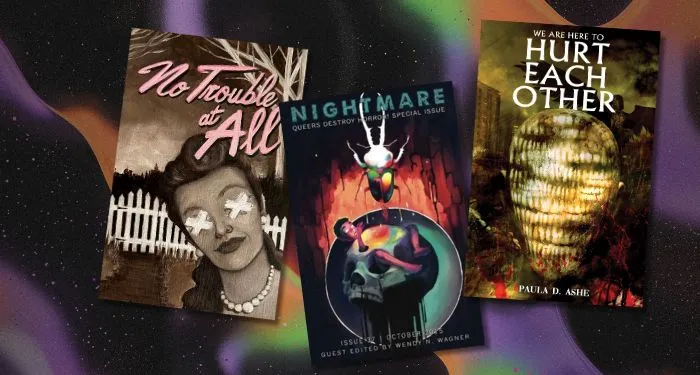One morning fifteen-year-old Cecilia awakens to discover she’s been transformed. Not into an insect but into something almost as alien—a teenager, peering into the abyss of adulthood. In Tessa Hadley’s short story “Cecilia Awakened,” the titular character is on a holiday in Italy with her parents. Everything is familiar: the hotel breakfast of “a jug of coffee…fresh rolls and white unsalted butter,” the oleander and bougainvillea growing on the terrace, the proprietress, Signora Petricci, whom Cecilia’s parents treat “as if she were an old friend.” But the trip feels all wrong. “Everything was ruined,” Cecilia complains. Her clothes rub her skin the wrong way, the signora looks upon her family with disdain, in the Uffizi she gazes at paintings she once loved “with a kind of horror.”
Cecilia’s earlier interests—art history, for instance—have vanished, along with the easy camaraderie she, an only child, once felt with her parents. Toward the end of the trip the family visits a church and her parents heedlessly, embarrassingly, descend into the sacristy without permission. A hostile monk approaches. “Che fate voi qui?” he asks: What are you doing here? Cecilia asks herself the same question, and flees alone to their hotel.
Here the story takes a turn. The third-person narration switches its attention from Cecilia to her mother, Angela, a novelist, as she imagines what Cecilia must be doing back at their room. Angela considers the “sheer blissful relief” of being alone in the cool, dark space, and pictures Cecilia flopping on the bed, then beginning “to prowl around the room, snooping idly, the way girls do, through her mother’s toiletries.” Angela’s mind moves to an old lipstick of her own mother’s that she has carried around for years; she reaches into her handbag to touch the metal cylinder for comfort.
Does Cecilia actually flop or prowl? We don’t find out, but with this shift in viewpoint Hadley stretches an invisible thread linking three generations of women, bound by the same rituals and growing pains—or so Angela thinks, at least. Cecilia is either an angsty brat or absolutely right about her slightly ridiculous parents; both feel equally true, which is the beauty of teenagers and of this story.
Hadley’s books—including eight novels and four short story collections, all published over the last twenty-five years—are full of girls and women facing monumental change: unexpected mothers, academic dropouts, accidental wives. She has a special talent for portraying the apparent fixedness of young adulthood—showing the way a girl’s convictions, whether about hemlines or romances or her parents’ failings, feel immovable and urgent, and how, when her expectations are thwarted, or altered, it can seem as if the backbone of life has perilously softened.
Publishing her first novel at the age of forty-six, Hadley had the kind of start in fiction that people often call late; much has been made of the fact that she, like so many of her characters, underwent a vocational transformation. (She had previously been a schoolteacher, completed a Ph.D., and raised a family.) Focusing on the past seventy years of working-class British life, often in and around Bristol and Wales, Hadley chronicles the ordinary experiences of young women in acute detail: teenage driving lessons, the unsettling sensation of wearing a swimsuit in front of the opposite sex, the restorative power of redecorating a room. They are all, as one of her characters explains, “struggling to block out some sort of shape of adult life for ourselves.” She has become the sort of everywoman writer who is casually compared to Jane Austen, Virginia Woolf, or Alice Munro, as if those three had much in common besides genius and gender.
What critics really mean by those comparisons is that Hadley writes domestic fiction, a notoriously backhanded designation. Her stories center on the family unit; they are set in kitchens more frequently than in offices. She examines small, seemingly trivial incidents—a child’s sandal lost in a pond, a glance out the spare bedroom window—that turn contentment into disillusionment (and sometimes slide back to contentment again). Hadley writes such calm and companionable prose that the rebellious nature of her characters’ choices emerges subtly, like a well-played card trick. Whether it’s a dissolving friendship, a phlegmatic marriage, or a wavering career, she is, as one critic put it, “in thrall to change, not progress.” Her great subject is the unfulfilled promise of womanhood, how youthful conviction is rooted out by the stark realities of adulthood.
Hadley’s early novels are baggier versions of what she perfected in her later fiction; they examine the numerous pitfalls of family life and reach across generations to show how a woman’s choices are amplified or flattened by her children. In her first novel, Accidents in the Home (2002), the focus is on Clare, a disillusioned young mother of three who embarks on a marriage-ending affair, and her mother, Marian, who abandoned her dissertation (about “women in the mob in the French Revolution”) to marry and have children, and now primarily watches over her aging father. Both women chafe at being caretakers and pine for a greater purpose.
Hadley’s next novel, Everything Will Be All Right (2003), is a familial group portrait of three women over the course of fifty years: Joyce; her daughter, Zoe; and Zoe’s daughter, Pearl, each of whom views her mother with a mixture of affection and condescension. In The Master Bedroom (2007) a professor gives up her career and moves from London back to the family estate outside Cardiff to care for her ailing mother, where she butts up against “the hard frame of adult necessity.” Yet rather than fill her with resentment, this forces her to reconsider the other parts of her life: Should she live with gusto or quiet resolve, take on lovers or buckle down to work? All these women feel change press upon them like a wave that will either thrillingly buoy them up or terrifyingly sweep them away.
Hadley surpassed her earlier work with Clever Girl (2013), an episodic bildungsroman of female certainty and uncertainty. Stella lives with her mother in a bedsit in 1960s Bristol; they’re a package deal, capable and satisfied with their lot even though Stella’s mother sleeps on a pullout couch. But from the outset it is made clear that their relationship will sour. “We were both strong-willed,” Stella offers in the opening pages,
and that was fine as long as we were pulling in tandem: both of us were fastidious and opinionated and ready to disapprove of other people’s tastes, though we kept these judgments diplomatically between us. (Later, our tastes diverged and we disapproved of each other.)
That parenthetical tells us what we need to know about Stella—that she is simultaneously straightforward and withholding, and that she draws a firm line between how she sees things now and how she saw them in childhood. As a character in Hadley’s 2007 short story “In the Country” puts it, “I don’t know which is more desolating: thinking how wrong I was then, or thinking that now I don’t believe in anything with that certainty.”
Stella bumps up against the pain and mendacity of the adult world at a young age. When she’s eight or nine, her Auntie Andy shows up to stay at their apartment, and Stella is told strictly not to mention her cousin Charlie: “I refused to ask my mother what had happened to him. I didn’t want to have unpacked for me whatever unseemly thing had made her face pulpy.” Over the years it “filter[s] through” to her that Charlie’s father, Derek, murdered him and left his body in the waterless tub. Some of the details that Stella learns don’t make their way to the reader—exactly how Charlie died, for instance. Hadley uses close third-person narration, but doesn’t want us to have every detail; instead we are left to wonder, like Stella did, and to recognize how narratives often take shape around the gaps in information.
At age ten, while at her nana’s for a sleepover, she wakes early and decides to head home. When she gets there her mother is not on the pullout, and it clearly has not been slept on. She hears noises from the bedroom, a man’s sleepy rumble. Stella’s reaction isn’t entirely what you’d expect. She feels rage, she admits, and disgust; she’s “appalled, invaded.” But mostly she feels a new freedom:
I had begun something catastrophic when I slipped out of the routines of our life, to act by myself…. But I wasn’t sorry. I was exulting—even though in my chest I felt a pain of postponed anxiety like a held breath.
She heads out on her own again, to the stables where she rides, a bus journey away. “I had worried sometimes about making the transition into being grown-up—how did you know when to begin?” she thinks. But the answer is obvious: “Now I understood that you stepped out into it, as simply as into a day.” Adulthood begins with one casual decision.
As the title hints, Stella grapples throughout her life with the question of whether her intelligence does her any good. In her adolescent years she’s enrolled at the local grammar school, an academic step up from the catch-all primary school, but she considers it “enemy territory,” a place “whose purpose was to grind you into its product,” and refuses to apply herself. Then one night while she’s attempting her physics homework her coffee spills onto her skirt. The distraction is banal but pivotal: suddenly she “could see all the elements of the problem differently now, as if they had arranged themselves naked under a bright light.” She understands the solution—acceleration equals two times distance over time squared, a formula that notably deals with how quickly something, or someone, can get to a desired location.
“That was how I got to know that I was clever,” she remembers. One of Hadley’s recurring subjects is the way women are defined by their relationship to that word, clever—from her earliest stories, she frequently marks her characters with it. A favorite of the Brits (I always imagine it said with a raised brow), it implies more than just brains. A clever woman is quick and ingenious, just as likely to adroitly maneuver a tricky conversation as to ace a test. A clever woman also knows when she isn’t getting her due. But in Hadley’s fiction that knowledge doesn’t always breed resentment. As the novel progresses, Stella’s life unfolds in segments—we see her unexpectedly pregnant as a teenager, working as a housekeeper to support her child, living in a communal house in the carefree 1970s, and then eventually, after years of keeping her cleverness “cramped and concealed,” coming back to her schooling. Yet in the end she doesn’t march off into a life of the mind. Hadley is clever enough to send her on an altogether less predictable course.
In Hadley’s sixth novel, The Past (2015), four siblings are faced with that most English of literary conundrums: whether to keep or sell their family’s now ramshackle country house. They gather there for three weeks, along with their children and some of their partners, to discuss the matter; though they have varying levels of attachment to the house, none has firm convictions either way. Hadley does houses gloriously well—she understands how redecoration can signal reinvention in character, and her women are always dressing up a poky flat with a thrifted tapestry or jaunty curtains—and this one is no exception: its dark 1970s linoleum kitchen floor and its French doors that open wide to a veranda are indicators, respectively, of the house’s past and its promise. The potential sale is also a stand-in for all the other things the siblings and their families are on the cusp of. One sister, Fran, is waffling about whether to leave her husband. The brother, Roland, has just remarried and has brought his new wife, along with a new sensibility (including a white suit and slick style), to meet the family. The two teenagers are about to tumble into adulthood, and over the course of the novel the two small children have their first encounters with sex (via some abandoned porn magazines) and death (via the decaying corpse of a dog found in an uninhabited cottage).
Hadley uses the book’s structure to reinforce the notion that the past is inescapably at the center of family life—that whatever the siblings decide about their lives has already been shaped by what came before them. The Past’s first and last sections chronicle those three weeks of sibling banter and colloquy, but the middle section slides backward to 1968 and the decision of their mother, Jill, to leave her husband and flee with the children back to her own parents in the country house. It’s a momentous move, not just because she is forsaking her marriage but because she was once a darling only child—like Cecilia—who then “disavowed her parents’ style so wholeheartedly”: moving back to their home signals a monumental failure. Surrounded again by their furnishings and judgments, she wonders whether an “absolute, creative transformation into a new life really were possible, and it was her fault that she couldn’t see it, and was stuck inside the old one.”
Jill, we later learn, is trapped in her marriage for dire reasons, but her question resounds across The Past. Can the siblings set aside their adolescent alliances and rivalries now that they have children of their own? What does it mean for them to let the house—an unchanged remnant of their young lives, with its smell of “imprisoned air” and its heavy old furniture—continue to crumble under their watch? And most potently, can anyone in this family change their lives in a way that their mother, bogged down by “all the apparatus of toys and baby-life,” could not?
Similar questions emerge in Hadley’s Free Love (2022), set in 1967, another novel of marital disarray. Pretty, peppy Phyllis is “pleased with her life” as a housewife and mother of two, but in the first chapter, after her hand grasps the shoulder of a much younger man at a dinner party, she is struck by the notion that she might be “sliding across serenely into middle age,” or worse, already “old and repulsive.” The two kiss in the garden that night, and Phyllis sees a new “version of her life story…spooling through her mind.” Here Hadley is interested in, as Elizabeth Bowen put it, “life with the lid on and what happens when the lid comes off.” Phyllis’s visits to the young man’s apartment in down-at-the-heels Notting Hill are not an aberration in her life but a complete revolution—sexual, political, domestic. One might say Phyllis starts the novel in a demure petticoat and ends it in bell-bottoms. And all that begins with a simple dinner party.
As early as her first novel, Hadley has used dinner parties to examine how readily, or warily, women and girls cling to traditional ideas of femininity. Accidents in the Home opens with Clare, a harried young mother, laboring over a meal for her beautiful best friend and the friend’s new boyfriend. Hadley writes that Clare’s concern about how the meal will go is tied up in her fear “that everything brilliant and savory about her might appear to have drained into that onion soup, leaving her wan and dull and domesticated.” In Clare’s mind, her looks and her personality are both too tangled up in her domestic role to separate.
Dinner parties can also bring transformation. In the 2014 story “One Saturday Morning,” adolescent Carrie is alone in the house while her parents shop for a dinner they’re hosting that evening when Dom, a friend of theirs, comes to the door. In direct contrast to her mother, who she knows will pull off the party with aplomb, Carrie feels “how inadequate she was to entertain him” and retreats upstairs. When her parents arrive home and Dom says he’s come to tell them of his young wife’s untimely death, the party takes on a new meaning for Carrie and the reader—it’s now a nod to a kind of normality that Carrie thinks she may never access again. She can’t rid herself of “the terrible knowledge that Dom had brought; it seemed to be stuck inside her”; her life, she realizes for the first time, is not impregnable.
In her most recent book, a novella fittingly called The Party, Hadley concentrates all these concerns down to a few bare, beautiful strokes of character and incident. Evelyn, a student in postwar Bristol, is in thrall to her older, more charismatic sister, Moira. In the first of three sections, “Vincent’s Party,” she follows Moira and her raucous crowd to a party at the bombed-out dockyards, where art students flirt and rub up against one another. Evelyn doesn’t enjoy herself, but she is changed by what she sees, galvanized by the possibility that she might take on a new maturity and, with it, confidence. In the third section, the two sisters attend another gathering, this time at the mansion of a young man they met at Vincent’s party. What starts as “playing at being grown up” turns into a game of strategy, with each character vying for attention and the chance to take someone to bed. By the evening’s end, both girls have inadvertently slept with the same man. The next morning, as they leave the house, the narrator observes:
Everything in the sisters’ future began unfolding from that morning. They were full of self-doubt, feeling unclean and flawed and conscious of wearing last night’s crumpled clothes—but in fact in that moment they appeared just as they most aspired to appear, veiled and opaque and desirable like the mysterious young women in a French film, with hidden lives full of significance and power.
But it’s the middle section, “Old Fright,” that lends that statement its weight. As in The Past, Hadley uses a tripartite structure to put a parent’s evolution at the center of her children’s story. At home between their two nights out, the sisters watch their mother, Rose—just forty-three but old to them—prepare for a cocktail party herself. The girls have the scorn of the young for the old: for their mother’s clothes, her faintly creased skin, the “shaming” fact of their father’s infidelity. She represents a version of adulthood that they can’t and don’t want to understand because it scares them—Rose, they believe, has lost her power along with her looks. And when Rose sits down at her dressing mirror she tells herself a similar story: “Old fright,” she says, but then she “coquet[s] her head on her neck nonetheless, out of habit,” a tic from her younger days, a small taste of who she used to, and still might, be.
Hadley slyly shows us how Rose and the girls stand at the edge of the uncharted terrain of womanhood. Their mother, who holds happiness in her hands “like a brimming dish that at some point would crash down,” is fading into what her daughters consider irrelevance. The girls, on the other hand, are just coming into their own.
Hadley’s subject, then, is becoming. But her characters don’t set off on some grand march toward enlightenment or happiness or empowerment. Her women—unlike those of so many of her peers—see their lives as a set of opportunities to invent and reinvent themselves (for better or worse) rather than settle for one identity, one purpose. Character, for Hadley, is not a stable element in the periodic table of literature. Girlhood, young adulthood, middle age—they are all just chances to turn into someone else entirely.



















 English (US) ·
English (US) ·